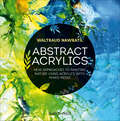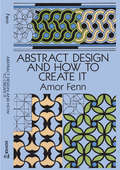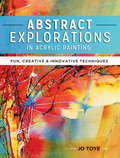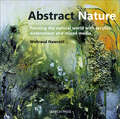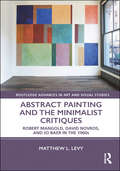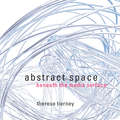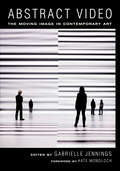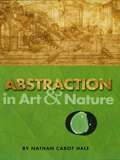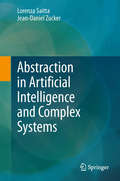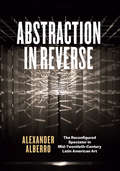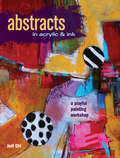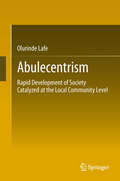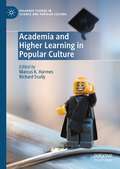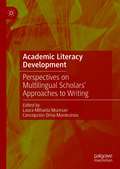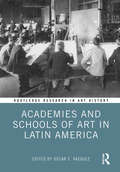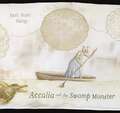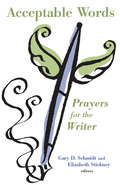- Table View
- List View
Abstract Acrylics: New Approaches to Painting Nature Using Acrylics with Mixed Media
by Waltraud NawratilAustrian artist Waltraud Nawratil shows you how to combine a love for nature with a passion for expressive abstract painting. The reader will learn how to use acrylics, watercolours or airbrushing, as well as natural materials such as sand, bark and leaves, to create captivating pictures full of colour and vitality.There is a wealth of stunning abstract pieces by Waltraud which will provide inspiration for more experienced painters as well as the beginner. The book covers the variations through the seasons, teaching the reader to see the natural world with creativity and a fresh new perspective.
Abstract Art Painting: Expressions in Mixed Media
by Debora StewartWould you love to take your art in a new direction? In Abstract Art Painting, you will enter a realm of tactile, intuitive excitement, combining pastel and acrylic to achieve results as unique as you are. You'll learn how to explore the use of color theory in abstraction and to use underpainting to bring structure and depth to your art. In addition you'll begin to understand how to work in a series and how this can help you develop your own personal style. A sampling of what you'll add to your creative toolbox: Pastel and acrylic techniques to use to complete your own paintings The benefits of expressing your ideas abstractly How to loosen up by using your nondominant hand and drawing to music Ways to express emotions through mark-making Using color and symbolism for expression Working with photos for inspiration Tips for using color studies Step into your own abstract frame of mind today!
Abstract Art: Second Edition (World of Art #0)
by Anna MoszynskaAn exceptionally clear, thorough, and well- illustrated introduction to abstract art since 1900. Since the early years of the twentieth century, Western abstract art has fascinated, outraged, and bewildered audiences. Its path to acceptance within the artistic mainstream was slow. This revised edition traces the origins and evolution of abstract art, placing it in broad cultural context. Well-respected scholar Anna Moszynska examines the pioneering work of Hilma af Klint, Wassily Kandinsky, Kazimir Malevich, and Piet Mondrian alongside the Russian Constructivists, the De Stijl group, and the Bauhaus artists, contrasting European geometric abstraction in the 1930s and ’40s with the emphasis on personal expression after World War II. Op, kinetic, and minimal art of the postwar period is discussed and illustrated in detail, and new chapters bring the account up to date, exploring the crisis in abstraction of the 1980s and its revival—in paint, fabric, sculpture, and installation—in recent decades. The first edition of Abstract Art, published in 1990, was acclaimed by reviewers. Revised with extensive updates, this book includes new chapters on recent trends and offers fully global coverage of art produced in North and South America, Europe, China, Korea, and the Middle East. Now in full color and comprehensively revised, it will serve as the best introduction to abstract art for a new generation.
Abstract Design and How to Create It (Dover Art Instruction)
by Amor FennStudents, designers, and craftspeople who want to create their own abstract patterns and designs will find this profusely illustrated guide one of the best books available on the subject. After an introductory chapter dealing with the geometric basis of design, the author goes on to discuss implements and their use (T-square, compass, dividers, ruling pen, etc.), borders, textile patterns, nature study, and treatment.Over 380 illustrations include many diagrams, designs for title pages, border patterns, allover patterns, textile patterns, and historical examples from an extraordinary number of cultures and periods: Assyrian stone carvings, Greek and Roman jewelry, 18th-century English silverwork, and more. Thorough and comprehensive, Abstract Design and How to Create It will be an invaluable resource for anyone seeking to learn the principles and techniques of creating nonrepresentative designs.
Abstract Explorations in Acrylic Painting: Fun, Creative and Innovative Techniques
by Jo ToyeDiscover abstract painting with acrylics! "If you approach your art with a playful attitude you will be more apt to keep making art, and the more art you make, the better your art will be." --pg. 10 Like a diving board for creativity, Abstract Explorations in Acrylic Painting will help you plunge joyfully into artmaking. With the belief that an attitude of playfulness is key to artistic growth, award-winning acrylic artist Jo Toye leads you on an engaging workshop-style adventure filled with innovative techniques, inventive approaches and breakthrough results.Work Small. Start by discovering how working on a small canvas yields big payoffs. When you don't have anything to lose but a few minutes and a little piece of paper, you'll find that you paint more fearlessly, absorb new concepts faster and enjoy yourself more.Step-by-Step Instruction. Learn what tools Toye finds most useful in making art, along with 17 step-by-step demonstrations showing how to use them to best effect.Start-to-Finish Painting Projects. At the heart of the book, 8 start-to-finish painting projects put it all together. Discover fresh takes on stenciling, sponging, making and working with gesso. Use razor blades and applicator bottles to create distinctive linework. Achieve wonderfully original patterns using resist pens, mouth atomizers and India ink. Experiment with Clear Tar Gel, pour paint with pipettes, work over top a "failed" painting...all yielding brilliantly original results. Heavily illustrated and filled with exciting ideas you won't find anywhere else, Abstract Explorations in Acrylic Painting will inspire you to paint, experiment, play...and come away with some of your best work yet!
Abstract Nature: Painting the Natural World with Acrylics, Watercolour and Mixed Media
by Waltraud NawratilWaltraud Nawratil teaches you how to express the natural world with creativity. Using a range of mediums such as acrylics, watercolour and mixed media – including elements from nature such as sand, bark and leaves – the reader learns to convey the natural world in a new and vivid light. Featuring a stunning range of Waltraud's own abstract art covering all four seasons.
Abstract Objects: For and Against (Synthese Library #422)
by José L. Falguera Concha Martínez-VidalThis volume examines the question “Do abstract objects exist?”, presenting new work from contributing authors across different branches of philosophy. The introduction overviews philosophical debate which considers: what objects qualify as abstract, what do we mean by the word "exist” and indeed, what evidence should count in favor or against the thesis that abstract objects exist. Through subsequent chapters readers will discover the ubiquity of abstract objects as each philosophical field is considered.Given the ubiquitous use of expressions that purportedly refer to abstract objects, we think that it is relevant to attend to the controversy between those who want to advocate the existence of abstract objects and those who stand against them. Contributions to this volume depict positions and debates that directly or indirectly involve taking one position or other about abstract objects of different kinds and categories. The volume provides a variety of samples of how positions for or against abstract objects can be used in different areas of philosophy in relation to different matters.
Abstract Painting and the Minimalist Critiques: Robert Mangold, David Novros, and Jo Baer in the 1960s (Routledge Advances in Art and Visual Studies)
by Matthew L. LevyThis book undertakes a critical reappraisal of Minimalism through an examination of three key painters: Robert Mangold, David Novros, and Jo Baer. By establishing their substantive engagements with Minimalist discourse, as well as their often overlooked artistic exchanges with their sculptor peers, it demonstrates that painting crucially informed the movement’s development, serving not only as an object of critique but also as a crucible for its most central tenets. It also poses broader disciplinary implications as it historicizes and challenges Minimalism’s "death of painting" critiques that have been so influential to theories of modernism and postmodernism in the visual arts.
Abstract Space: Beneath the Media Surface
by Therese TierneyThis visually stunning, conceptually rich and imaginative book investigates the cultural connection between new media and architectural imaging. Through a range of material, from theoretical texts to experimental design projects, Tierney explores notions of what the architectural image means today. Within the book's visually imaginative design framework, Abstract Space engages discourses from architecture, visual and cultural studies to computer science and communications technology to present an in-depth multi-media case study. Tracing a provisional history of the topic, the book also lends a provocative and multivalent understanding to the complex relations affecting the architectural image today.
Abstract Video: The Moving Image in Contemporary Art
by Gabrielle JenningsOffering historical and theoretical positions from a variety of art historians, artists, curators, and writers, this groundbreaking collection is the first substantive sourcebook on abstraction in moving-image media. With a particular focus on art since 2000, Abstract Video addresses a longer history of experimentation in video, net art, installation, new media, expanded cinema, visual music, and experimental film. Editor Gabrielle Jennings—a video artist herself—reveals as never before how works of abstract video are not merely, as the renowned curator Kirk Varnedoe once put it, "pictures of nothing," but rather amorphous, ungovernable spaces that encourage contemplation and innovation. In explorations of the work of celebrated artists such as Jeremy Blake, Mona Hatoum, Pierre Huyghe, Ryoji Ikeda, Takeshi Murata, Diana Thater, and Jennifer West, alongside emerging artists, this volume presents fresh and vigorous perspectives on a burgeoning and ever-changing arena of contemporary art.
Abstraction in Art and Nature (Dover Art Instruction)
by Nathan Cabot HaleIn this stimulating, thought-provoking guide, a noted sculptor and teacher demonstrates how to discover a rich new design source in the abstractions inherent in natural forms. Through systematic study of such properties as line, form, shape, mass, pattern, light and dark, space, proportion, scale, perspective, and color as they appear in nature, students can learn to utilize the infinite variety and diversity of those elements as a wellspring of creative abstraction. The author invites students to learn the necessary techniques through a series of projects devoted to exploring and drawing plants, animals, birds, landscapes, seascapes, skies, and more. Lines of growth and structure, water and liquid forms, weather and atmospheric patterns, luminosity in plants and animals, earth colors and lightning are among the sources of abstraction available to the artist who is aware of them. This book will train you to see and use these elements and many more. An intriguing blend of art, psychology, and the natural sciences, Abstraction in Art and Nature is profusely illustrated with over 370 photographs, scientific illustrations, diagrams, and reproductions of works by the great masters. It not only offers a mind-stretching new way of learning and teaching basic design, but deepens our awareness of the natural environment. In short, Mr. Hale's book is an indispensable guide that artists, teachers, and students will want to have close at hand for instruction, inspiration, and practical guidance.
Abstraction in Artificial Intelligence and Complex Systems
by Jean-Daniel Zucker Lorenza SaittaAbstraction is a fundamental mechanism underlying both human and artificial perception, representation of knowledge, reasoning and learning. This mechanism plays a crucial role in many disciplines, notably Computer Programming, Natural and Artificial Vision, Complex Systems, Artificial Intelligence and Machine Learning, Art, and Cognitive Sciences. This book first provides the reader with an overview of the notions of abstraction proposed in various disciplines by comparing both commonalities and differences. After discussing the characterizing properties of abstraction, a formal model, the KRA model, is presented to capture them. This model makes the notion of abstraction easily applicable by means of the introduction of a set of abstraction operators and abstraction patterns, reusable across different domains and applications. It is the impact of abstraction in Artificial Intelligence, Complex Systems and Machine Learning which creates the core of the book. A general framework, based on the KRA model, is presented, and its pragmatic power is illustrated with three case studies: Model-based diagnosis, Cartographic Generalization, and learning Hierarchical Hidden Markov Models.
Abstraction in Reverse: The Reconfigured Spectator in Mid-Twentieth-Century Latin American Art
by Alexander AlberroDuring the mid-twentieth century, Latin American artists working in several different cities radically altered the nature of modern art. Reimagining the relationship of art to its public, these artists granted the spectator an unprecedented role in the realization of the artwork. The first book to explore this phenomenon on an international scale, Abstraction in Reverse traces the movement as it evolved across South America and parts of Europe. Alexander Alberro demonstrates that artists such as Tomás Maldonado, Jesús Soto, Julio Le Parc, and Lygia Clark, in breaking with the core tenets of the form of abstract art known as Concrete art, redefined the role of both the artist and the spectator. Instead of manufacturing autonomous art, these artists produced artworks that required the presence of the spectator to be complete. Alberro also shows the various ways these artists strategically demoted regionalism in favor of a new modernist voice that transcended the traditions of the nation-state and contributed to a nascent globalization of the art world.
Abstracts In Acrylic and Ink: A Playful Painting Workshop
by Jodi OhlSplatter, stamp, scrape, repeat. A quick-start guide to beautifully layered and textured abstracts! While there are many approaches to painting abstract art, Jodi Ohl's philosophy is to simply start. In this book, the successful, self-taught artist helps you "dive in with an open mind and fearless heart." Everything inside is geared toward kick-starting your creativity:An exciting series of 22 fun-to-follow, step-by-step projects.A tantalizing variety of approaches and inspirations for applying and manipulating paint, crayons, pencils, ink, paper, photos and more.Quick and loose exercises for building a library of ideas, color palettes, patterns and designs to use in future paintings.Loads of practical advice, including how to stock your studio without going broke, the five must-haves mediums, and how to finish and protect your artwork.For beginners eager to get to the "good stuff" and for artists looking to expand their repertoire, it just doesn't get any better.Every action-packed page will have you trying something new and pushing your boundaries! Make marbled acrylic skins * Add a stain * Discover instant gratification with Yupo paper * Achieve the wonderfully aged look of image transfers * Play with graffiti-style art * Experiment with gel mediums * Incorporate non-commercial add-ins like eggshells and netting * Create incredible abstract landscapes and cityscapes * And so much more!
Abulecentrism: Rapid Development of Society Catalyzed at the Local Community Level
by Olurinde LafeThe book describes a development concept called abulecentrism. The Yoruba word abule (pronounced: a-boo-lay) literarily means "the village". abulecentrism seeks to achieve rapid and sustainable development of a given society by the strategic execution of projects and the provision of critical services at the local community level. The village has always been the traditional unit of communal living in many societies around the world. The typical village is small, comprising close-knit social groups and individuals that number in the tens, or at most, low hundreds. In a village, people live close to one another, and derive strength in their communal methods of living, working and protecting their society. Furthermore, the management and governance of the community is simpler than in urban areas because the village requires smaller administrative systems. abulecentrism is built on the philosophy of using small, modular systems, such as a village, as building blocks for developing the greater society. The ultimate goal of abulecentrism is for the larger society to be significantly impacted by the dividends of the aggregated development attained within the different communities. Development projects will typically be executed by starting with a few local communities and progressing organically until all the communities that make up the larger society have been impacted.
Academia and Higher Learning in Popular Culture (Palgrave Studies in Science and Popular Culture)
by Marcus K. Harmes Richard ScullyThis edited volume focuses on the cultural production of knowledge in the academy as mediated or presented through film and television. This focus invites scrutiny of how the academy itself is viewed in popular culture from The Chair to Terry Pratchett's ‘Unseen University’ and Doctor Who's Time Lord Academy among others. Spanning a number of genres and key film and television series, the volume is also inherently interdisciplinary with perspectives from History, Cultural Studies, Gender Studies, STEM, and more. This collection brings together leading experts in different disciplines and from different national backgrounds. It emphasises that even at a point of mass, global participation in higher education, the academy is still largely mediated by popular culture and understood through the tropes perpetuated via a multimedia landscape.
Academia from the Inside: Pedagogies for Self and Other
by Maureen P. Hall Aubrie K. BraultThis book invites readers to explore how fourteen different experts in their respective fields create deeper meaning in their profession and work with students through thinking, in multiple ways, about the self who teaches, the self who learns, and the ways in which these selves interact within the academy. Essays in this book explore the “inside” of academia through three themes: Pursuing Authenticity, Creating Creative Community, and Humanizing Education. Contributors reflect on their own lived experiences in the academy and on pedagogies that they have created for their students. Embodied education, the theoretical framework of this book, draws on ideas of educators Parker Palmer from the West and Dr. Chinmay Pandya from the East, emerging through contributors’ collaborative work. In embodied education, teachers and learners share experiences that lead to self-understanding and together find ways to humanize spaces in academia.
Academic Keywords: A Devil's Dictionary for Higher Education
by Cary Nelson Stephen WattKnow what academic freedom is? Or what it's come to mean? What's affirmative about affirmative action these days? Think you're up on the problem of sexual harassment on campus? Or know how much the university depends on part-time faculty? Academic Keywords is a witty, informed, and sometimes merciless assessment of today's campus, an increasingly corporatized institution that may have bitten off more than its administration is ready to chew. Cary Nelson and Steve Watt use the format of a dictionary to present stories and reflections on some of the most pressing issues affecting higher education in America. From the haphazard treatment of graduate students to the use and abuse of faculty (as well as abuses commited by faculty), Nelson and Watt present a compelling and, at times, enraging report on the state of the campus.
Academic Literacy Development: Perspectives on Multilingual Scholars' Approaches to Writing
by Laura-Mihaela Muresan Concepción Orna-MontesinosThis edited book brings together an international cast of contributors to examine how academic literacy is learned and mastered in different tertiary education settings around the world. Bringing to the fore the value of qualitative enquiry through ethnographic methods, the authors illustrate in-depth descriptions of genre knowledge and academic literacy development in first and second language writing. All of the data presented in the chapters are original, as well as innovative in the field in terms of content and scope, and thought-provoking regarding theoretical, methodological and educational approaches. The contributions are also representative of both novice and advanced academic writing experiences, providing further insights into different stages of academic literacy development throughout the career-span of a researcher. Set against the backdrop of internationalisation trends in Higher Education and the pressure on multilingual academics to publish their research outcomes in English, this volume will be of use to academics and practitioners interested in the fields of Languages for Academic Purposes, Applied Linguistics, Literacy Skills, Genre Analysis and Acquisition and Language Education.
Academies and Schools of Art in Latin America (Routledge Research in Art History)
by Oscar E. VázquezThis edited volume’s chief aim is to bring together, in an English-language source, the principal histories and narratives of some of the most significant academies and national schools of art in South America, Mexico, and the Caribbean, from the late 18th to the early 20th centuries. The book highlights not only issues shared by Latin American academies of art but also those that differentiate them from their European counterparts. Authors examine issues including statutes, the influence of workshops and guilds, the importance of patronage, discourses of race and ethnicity in visual pedagogy, and European models versus the quest for national schools. It also offers first-time English translations of many foundational documents from several significant academies and schools. This book will be of interest to scholars in art history, Latin American and Hispanic studies, and modern visual cultures.
Acadiana: Louisiana's Historic Cajun Country
by Philip Gould Carl A. Brasseaux"Acadiana" summons up visions of a legendary and exotic world of moss-draped cypress, cocoa-colored bayous, subtropical wildlife, and spicy indigenous cuisine. The ancestral home of Cajuns and Creoles, this twenty-two-parish area of south Louisiana encompasses a broad range of people, places, and events. In their historical and pictorial tour of the region, author Carl A. Brasseaux and photographer Philip Gould explore in depth this fascinating and complex world.As passionate documentarians of all things Cajun and Creole, Brasseaux and Gould delve into the topography, culture, and economy of Acadiana.In two hundred color photographs of architecture, landscapes, wildlife, and artifacts, Gould portrays the rich history still visible in the area, while Brasseaux's engagingly written narrative covers the eighteenth- and nineteenth-century story of settlement and development in the region. Brasseaux brings the story up to date, recounting devastating hurricanes and coastal degradation.From living-history attractions such as Vermilionville, the Acadian Village, and Longfellow-Evangeline State Park to music venues, festivals, and crawfish boils, Acadiana depicts a resilient and vibrant way of life and presents a vivid portrait of a culture that continues to captivate, charm, and endure.For all those who want to explore these people and this place, Brasseaux and Gould have provided an insightful written and visual history.
Accalia and the Swamp Monster
by Kelli Scott KelleyAs the author and artist of a heroine's surreal journey through a haunting southern landscape, Kelli Scott Kelley reveals the mastery of her craft and the strong narrative ability of her artwork. Borrowing from Roman mythology, Jungian analysis, and the psychology of fairy tales, Kelley presents a story of family dysfunction, atonement, and transformation.Reproductions of her artwork -- mixed-media paintings executed on repurposed antique linens -- punctuate the tale of Accalia, who is tasked with recovering the arms of her father from the belly of the swamp monster. Visually and metaphorically, Accalia's odyssey enchants and displaces as Kelley delicately balances the disquieting with the familiar. Rich in symbolism and expertly composed, Accalia and the Swamp Monster pulls readers into the physical realm through Kelley's chimerical imagery and then pushes them towards the inner world of the subconscious. To that end, Kelley's story is accompanied by essays from Jungian analyst Constance Romero and art historian Sarah Bonner.A culmination of nearly a decade of work, introspection, and research, Accalia and the Swamp Monster is both an entrancing display of Kelley's art and an affirmation of the transformative power of fairy tales.
Accelerating Sustainability Using the 80/20 Rule
by Gareth KaneAre your sustainability efforts making as much impact as they could be?With our collective way of life rubbing up against the natural limits of the planet, it does not take a genius to see that it is time to scrape the mud off our boots and find a shorter, smarter path towards sustainability – a way to maximize our effectiveness and inspire leaps forward in sustainability, rather than incremental steps. The 80/20 rule says that, in many situations, a small number of inputs determine the vast majority of our desired results. If we identify these “vital few” inputs in our sustainability efforts, and focus on them, we can maximize our effectiveness and accelerate progress rapidly. This book will help you to think about sustainability from an 80/20 perspective with practical applications for: product and service development; supply chains; materiality, indicators and quantitative analysis; waste, energy efficiency, water conservation and transport; employee engagement and sustainability strategy. If you want to focus on what works, deliver better results, waste less time on “switch it off” stickers and ineffective “standard practice” and start making a real difference, then this book is for you!
Accelerating the Socio-Ecological Transition: Strategies and Innovations for Sustainable Development
by Mohamed Cheriet Jean-François Boucher Luciana Gondim de Almeida Guimarães Jean-Marc FrayretThis book explores the key principles and challenges of implementing the socio-ecological transition, with a particular focus on Quebec, Canada. It addresses these issues from both research and educational perspectives, offering actionable strategies to accelerate this transition across the province's various economic sectors. The book's structure aligns with the CIRODD (Interdisciplinary Research Center for Operationalization of Sustainable Development) scientific program, organized into two major sections and 11 thematic areas. The objective is to showcase the latest advancements in socio-ecological transition, drawing on a decade of research contributions from CIRODD. This book edition will highlight key innovations, emerging trends, and impactful solutions that have shaped the field, demonstrating CIRODD&’s pivotal role in driving sustainable transformation. Section 1 delves into practical interventions and strategies for citizen engagement, exploring transition initiatives, urban planning, and collaborative knowledge-building models. It brings together theoretical, practical, and experiential insights, emphasizing the vital role of research and the arts in facilitating the socio-ecological transition. Section 2 equips readers with the necessary tools to support this transition, offering models and methods for analyzing complex systems. It highlights innovative digital approaches for developing circular and sustainable business models. This is an open access book.
Acceptable Words: Prayers for the Writer
by Gary Schmidt Elizabeth StickneyAcceptable Words offers prayers that correspond with each stage of the writer's work -- from finding inspiration to penning the first words to "offering it to God" at completion. Gary Schmidt and Elizabeth Stickney, experienced writers themselves, introduce each chapter of prayers with pithy pastoral reflections that will encourage writers in their craft.This welcome spiritual resource for writers includes both ancient and contemporary poems and prayers -- some of which were written especially for this volume. A thoughtful gift for any writer, Acceptable Words will accompany writers on their spiritual journey, lending words of praise and petition specifically crafted to suit their unique vocation.Watch the trailer:
